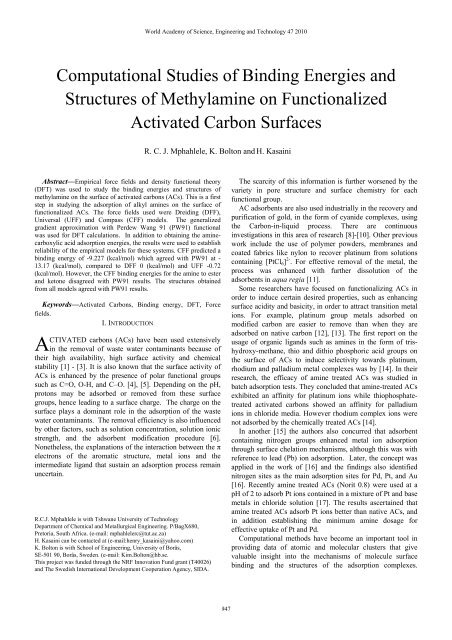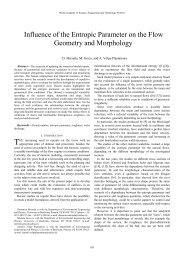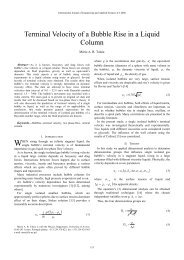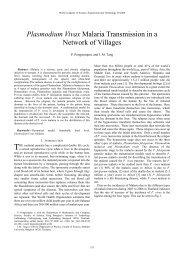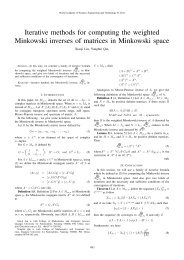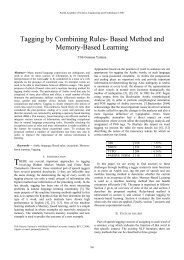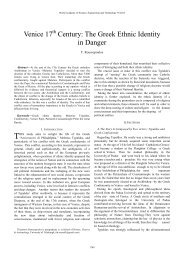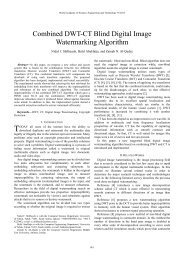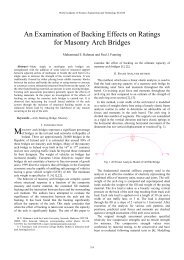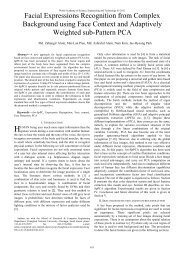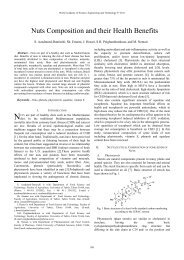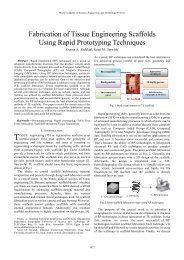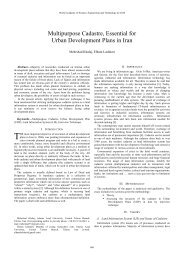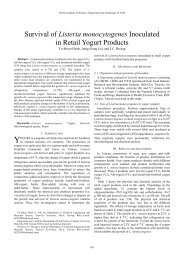Computational Studies of Binding Energies and Structures of ...
Computational Studies of Binding Energies and Structures of ...
Computational Studies of Binding Energies and Structures of ...
You also want an ePaper? Increase the reach of your titles
YUMPU automatically turns print PDFs into web optimized ePapers that Google loves.
World Academy <strong>of</strong> Science, Engineering <strong>and</strong> Technology 47 2010<strong>Computational</strong> <strong>Studies</strong> <strong>of</strong> <strong>Binding</strong> <strong>Energies</strong> <strong>and</strong><strong>Structures</strong> <strong>of</strong> Methylamine on FunctionalizedActivated Carbon SurfacesR. C. J. Mphahlele, K. Bolton <strong>and</strong> H. KasainiAbstract—Empirical force fields <strong>and</strong> density functional theory(DFT) was used to study the binding energies <strong>and</strong> structures <strong>of</strong>methylamine on the surface <strong>of</strong> activated carbons (ACs). This is a firststep in studying the adsorption <strong>of</strong> alkyl amines on the surface <strong>of</strong>functionalized ACs. The force fields used were Dreiding (DFF),Universal (UFF) <strong>and</strong> Compass (CFF) models. The generalizedgradient approximation with Perdew Wang 91 (PW91) functionalwas used for DFT calculations. In addition to obtaining the aminecarboxylicacid adsorption energies, the results were used to establishreliability <strong>of</strong> the empirical models for these systems. CFF predicted abinding energy <strong>of</strong> -9.227 (kcal/mol) which agreed with PW91 at -13.17 (kcal/mol), compared to DFF 0 (kcal/mol) <strong>and</strong> UFF -0.72(kcal/mol). However, the CFF binding energies for the amine to ester<strong>and</strong> ketone disagreed with PW91 results. The structures obtainedfrom all models agreed with PW91 results.Keywords—Activated Carbons, <strong>Binding</strong> energy, DFT, Forcefields.I. INTRODUCTIONACTIVATED carbons (ACs) have been used extensivelyin the removal <strong>of</strong> waste water contaminants because <strong>of</strong>their high availability, high surface activity <strong>and</strong> chemicalstability [1] - [3]. It is also known that the surface activity <strong>of</strong>ACs is enhanced by the presence <strong>of</strong> polar functional groupssuch as C=O, O-H, <strong>and</strong> C–O. [4], [5]. Depending on the pH,protons may be adsorbed or removed from these surfacegroups, hence leading to a surface charge. The charge on thesurface plays a dominant role in the adsorption <strong>of</strong> the wastewater contaminants. The removal efficiency is also influencedby other factors, such as solution concentration, solution ionicstrength, <strong>and</strong> the adsorbent modification procedure [6].Nonetheless, the explanations <strong>of</strong> the interaction between the πelectrons <strong>of</strong> the aromatic structure, metal ions <strong>and</strong> theintermediate lig<strong>and</strong> that sustain an adsorption process remainuncertain.R.C.J. Mphahlele is with Tshwane University <strong>of</strong> TechnologyDepartment <strong>of</strong> Chemical <strong>and</strong> Metallurgical Engineering. P/BagX680,Pretoria, South Africa. (e-mail: mphahlelerc@tut.ac.za)H. Kasaini can be contacted at (e-mail:henry_kasaini@yahoo.com)K. Bolton is with School <strong>of</strong> Engineering, University <strong>of</strong> Borås,SE-501 90, Borås, Sweden. (e-mail: Kim.Bolton@hb.se.This project was funded through the NRF Innovation Fund grant (T40026)<strong>and</strong> The Swedish International Development Cooperation Agency, SIDA.The scarcity <strong>of</strong> this information is further worsened by thevariety in pore structure <strong>and</strong> surface chemistry for eachfunctional group.AC adsorbents are also used industrially in the recovery <strong>and</strong>purification <strong>of</strong> gold, in the form <strong>of</strong> cyanide complexes, usingthe Carbon-in-liquid process. There are continuousinvestigations in this area <strong>of</strong> research [8]-[10]. Other previouswork include the use <strong>of</strong> polymer powders, membranes <strong>and</strong>coated fabrics like nylon to recover platinum from solutionscontaining [PtCl 6 ] 2- . For effective removal <strong>of</strong> the metal, theprocess was enhanced with further dissolution <strong>of</strong> theadsorbents in aqua regia [11].Some researchers have focused on functionalizing ACs inorder to induce certain desired properties, such as enhancingsurface acidity <strong>and</strong> basicity, in order to attract transition metalions. For example, platinum group metals adsorbed onmodified carbon are easier to remove than when they areadsorbed on native carbon [12], [13]. The first report on theusage <strong>of</strong> organic lig<strong>and</strong>s such as amines in the form <strong>of</strong> trishydroxy-methane,thio <strong>and</strong> dithio phosphoric acid groups onthe surface <strong>of</strong> ACs to induce selectivity towards platinum,rhodium <strong>and</strong> palladium metal complexes was by [14]. In theirresearch, the efficacy <strong>of</strong> amine treated ACs was studied inbatch adsorption tests. They concluded that amine-treated ACsexhibited an affinity for platinum ions while thiophosphatetreatedactivated carbons showed an affinity for palladiumions in chloride media. However rhodium complex ions werenot adsorbed by the chemically treated ACs [14].In another [15] the authors also concurred that adsorbentcontaining nitrogen groups enhanced metal ion adsorptionthrough surface chelation mechanisms, although this was withreference to lead (Pb) ion adsorption. Later, the concept wasapplied in the work <strong>of</strong> [16] <strong>and</strong> the findings also identifiednitrogen sites as the main adsorption sites for Pd, Pt, <strong>and</strong> Au[16]. Recently amine treated ACs (Norit 0.8) were used at apH <strong>of</strong> 2 to adsorb Pt ions contained in a mixture <strong>of</strong> Pt <strong>and</strong> basemetals in chloride solution [17]. The results ascertained thatamine treated ACs adsorb Pt ions better than native ACs, <strong>and</strong>in addition establishing the minimum amine dosage foreffective uptake <strong>of</strong> Pt <strong>and</strong> Pd.<strong>Computational</strong> methods have become an important tool inproviding data <strong>of</strong> atomic <strong>and</strong> molecular clusters that givevaluable insight into the mechanisms <strong>of</strong> molecule surfacebinding <strong>and</strong> the structures <strong>of</strong> the adsorption complexes.947
World Academy <strong>of</strong> Science, Engineering <strong>and</strong> Technology 47 2010Calculations based on density functional theory (DFT) <strong>and</strong>empirical force fields have been used successfully in theprediction <strong>of</strong> gas solid interactions <strong>and</strong> the calculation <strong>of</strong>binding energies on the surfaces <strong>of</strong> carbon based adsorbents[18], [19]. DFT <strong>and</strong> quantum chemical molecular dynamicshave been used successfully for cyclo-propane adsorption ontocopper surfaces [20]. The adsorption energies obtained werecomparable to experimental data <strong>and</strong> the structural propertiesobtained from quantum molecular dynamics calculations wereconsistent with those obtained from DFT methods. Acombination <strong>of</strong> DFT <strong>and</strong> empirical force fields to studygraphite surface template structures <strong>of</strong> bis-(terpyridine)derivatives was also applied in the work <strong>of</strong> [21]. The authorsassessed, among others, the suitability <strong>of</strong> each force field(DFF, UFF <strong>and</strong> CFF) in interpreting geometric parameters,<strong>and</strong> structural conformities <strong>of</strong> these derivatives. Theyconcluded that geometric parameters were describedadequately by all force fields. However, there was adiscrepancy in the calculated torsion angles. The CFF gave thebest adsorption energies <strong>of</strong> the three empirical force fields.Similar computational methods to those used by [21] areused in this contribution to study the adsorption <strong>of</strong>methylamine (CH 3 NH 2 ) on benzocarboxylic acid(C 6 H 5 COOH). This is an initial step towards studying theadsorption <strong>of</strong> amines on several activated carbon (AC)functional groups, which has been used in the experiments <strong>of</strong>[7], [13], <strong>and</strong> [14]. In these experiments the amine groupswere adsorbed onto the AC surface at pH 10, where surfacecharge was slightly negative <strong>and</strong> constant, before a Pt metalion solution at pH 2 was introduced to the system. Here wefocus on the first step, i.e., adsorption <strong>of</strong> amines on the AC,wherein the ACs simulated corresponds to the surface chargeattained by native ACs when they are in a solution at pH 10,with the future aim <strong>of</strong> extending this work to the adsorption <strong>of</strong>Pt ions on the amine-treated surface. This work thereforeserves as a preliminary step in the development <strong>of</strong> a carbonbased adsorbent, tailor-made for the separation <strong>of</strong> platinumgroup metals existing in low concentrations <strong>of</strong> 50 ppm <strong>and</strong>below, found in waste water <strong>and</strong> barren solutions from miningeffluents.In the present contribution we focus on methylamine(CH 3 NH 2 ) adsorbed on benzocarboxylic acid (C 6 H 5 COOH).This system is used to model the experimental situation whereamines, usually with 4 carbon entities, are adsorbed onfunctionalized AC. It is a sufficiently small system to allowfor accurate DFT calculations, while at the same time it isexpected to yield qualitatively correct chemistry. We focus onthe carboxylic acid functional group since our calculationsindicate that this group yields the largest binding energy to theamine, as compared to ether, ketone, ester <strong>and</strong> C=C groups.Some results from the ketone <strong>and</strong> ester groups, which havelarger binding energies than the ether <strong>and</strong> C=C groups, arealso given. The CH 3 NH 2 <strong>and</strong> C 6 H 5 COOH molecules areneutral in these calculations since this is the simplest system totest the validity <strong>of</strong> the empirical force fields studied here. Theimportance <strong>of</strong> positively charged surfaces, which is moreimportant at the low pHs when the Pt ions are introduced tothe surface-modified AC, will be addressed in future work.The empirical force fields used in this work are the same asthose used in [21] (i.e. DFF; UFF <strong>and</strong> CFF) <strong>and</strong> thegeneralized gradient approximation (GGA) with the PerdewWang 91 (PW91) functional was used for the DFTcalculations. The aim <strong>of</strong> the study is two-fold: First to obtainthe chemical structure <strong>and</strong> binding energy for the CH 3 NH 2 –C 6 H 5 COOH, which is expected to be typical for the moregeneral amine-carboxylic acid AC surface <strong>and</strong>, second todetermine which, if any, <strong>of</strong> the empirical force fields providesa valid description <strong>of</strong> these systems. The results obtained inthese studies forms the base for future studies focusing on theeffect <strong>of</strong> hydration on the adsorption structures <strong>and</strong> energies,as well as the adsorption <strong>of</strong> platinum ions in chloride media[PtCl 6 2 , PtCl 4 2- <strong>and</strong> PdCl 2 2- ] to the functionalized AC surface.II. MODELS AND METHODSThe three empirical force fields used in this study are thesame as those used in previous studies <strong>of</strong> molecular adsorptionon graphite [21]. They are the Compass (CFF), Dreiding(DFF) <strong>and</strong> Universal (UFF) force fields as implemented in theMaterials Studio® s<strong>of</strong>tware package [22]. The CFF has beenoptimized to both ab initio <strong>and</strong> empirical data for condensedphase applications <strong>and</strong> has been widely used in simulations <strong>of</strong>liquids, crystals, <strong>and</strong> polymers, including some transitionalmetals such as Cr, Ni, Pd, Pt etc. [23]. The DFF is commonlyused in the prediction <strong>of</strong> structures <strong>and</strong> dynamics studies <strong>of</strong>organic, main group inorganic <strong>and</strong> biological systems. Itsfunctional form is detailed in [24]. The UFF is based on bondhybridization <strong>and</strong> connectivity, <strong>and</strong> is thus applicable to allelements in the periodic table [25]. Although the use <strong>of</strong> forcefields in studying complex surface structures <strong>and</strong> mechanicalproperties is still not common, their application in polymer,composite materials <strong>and</strong> protein research has advanced [26]-[28].In this work density functional theory (DFT) was used toobtain more accurate results for the CH 3 -NH 2 – C 6 H 5 COOHbinding energy <strong>and</strong> structure <strong>and</strong> to assess the validity <strong>of</strong> thethree empirical force fields. DFT was chosen for this studysince it yields accurate atomic energies <strong>and</strong> reaction barriersfor molecular systems [29] in a computationally tractable time,which is not the case for post Hartree-Fock methods that givesimilar accuracy. In this work the calculations were based onthe generalized gradient approximation (GGA) [30]parameterized by Perdew Wang 91 functional (PW91) [31],which is known to yield good prediction <strong>of</strong> Van der Waalsinteractions in organic <strong>and</strong> hydrogen bonded systems [32],[33].The activated carbon (AC) was represented by a singlebenzene ring, functionalized with carboxylic acid, ester,ketone, ether or C=C groups. This is illustrated for ester <strong>and</strong>ketone groups in Fig. 1. This model was chosen since it is thesimplest molecule that includes the functional group <strong>and</strong> thearomatic ring that is expected to be found in the AC.948
World Academy <strong>of</strong> Science, Engineering <strong>and</strong> Technology 47 2010Preliminary calculations done in our group indicate that thecarboxylic acid group shows the largest binding energy to theamine, <strong>and</strong> hence we focus on this functional group in thiscontribution. Comparison was made with some resultsobtained for the ester <strong>and</strong> ketone groups, which have largerbinding energies than the ether <strong>and</strong> C=C groups. The aminewas modeled by the CH 3 -NH 2 molecule.principle, this is not necessary if two <strong>of</strong> the force fieldsyielded the same structure, but all nine calculations wereperformed here to ensure completeness. The first Brillouinezone was sampled using Monkhorst–Pack technique. For thisnon metallic system, fine meshes <strong>of</strong> 2 x 2 x 2 k-points weregenerated in a non periodic super cell <strong>of</strong> 30 x 30 x 30 Ǻ. Thecell size was set so that subsequent computations involvingwater <strong>and</strong> Pt ions can be done without changing the cell size(platinum chloride complexes require larger cell dimensions).The results <strong>of</strong> the PW91 geometry optimizations were usedas follows: First, the energies for any given structure (e.g., theamine) that were obtained when using input from the threedifferent force fields were compared. The force field that gavethe structure that yielded the lowest energy gives the bestdescription <strong>of</strong> the molecule complex, provided the PW91optimization does not significantly change the input geometry.Second, the binding energy was calculated using (1) [34]: , (1)a) Activated Carbon functionalized with an Ester group. is the energy for functionalized AC bound to theamine, e.g., for the CH 3 NH 2 – C 6 H 5 COOH complex shown inFig. 2. , is the minimum energy <strong>of</strong> the functionalized ACmodel, e.g., C 6 H 5 COOH, <strong>and</strong> is for the amine group.The binding energy calculated from the PW91 method (afteroptimization from the inputs obtained from the three differentforce fields) was compared to the energies calculated directlyfrom the corresponding force field. A good agreementbetween the binding energies obtained from the force fields<strong>and</strong> the DFT calculations indicates that the force fields providea valid description for these systems.b) AC functionalized with a ketone group.Fig. 1 <strong>Structures</strong> used to model the ester (a) <strong>and</strong> ketone (b)functionalized AC. The structures were obtained by annealing usingthe CFF <strong>and</strong> then geometry optimization with PW91.Minimum energy geometries for the CH 3 -NH 2 <strong>and</strong>C 6 H 5 COOH molecules as well as the CH 3 NH 2 – C 6 H 5 COOHcomplex were obtained for each <strong>of</strong> the three force fields byfirst performing a geometry optimization <strong>and</strong> then a simulatedannealing (i.e., nine minimum energy geometries wereobtained). The simulated annealing was performed in anattempt to locate a chemically relevant or global minimum.Each molecule <strong>and</strong> complex was annealed over 50 cycles at aninitial temperature <strong>of</strong> 300 (K) <strong>and</strong> a mid-cycle temperature <strong>of</strong>500 (K). This temperature range was chosen since it allowedthe molecule complex to transverse energy barriers while, atthe same time, not allowing dissociation. Geometryoptimization was done between each cycle, <strong>and</strong> the minimumenergy configuration was the structure with the lowest energy.The nine minimum energy structures obtained from thesimulated annealing (three structure for each force field) wereused as input coordinates for the PW91 calculations. InFig. 2 Structure used to model the carboxylic acid functionalized AC– amine complex. The structure was obtained by annealing using theCFF <strong>and</strong> then geometry optimization with PW91.III. RESULTS AND DISCUSSIONSA. Methylamine (CH 3 NH 2 )A typical structure for the CH 3 NH 2 molecule is shownin fig. 3 .The figure also shows the labels used in Table I.It must be noted that the literature data is not specific forthe CH 3 NH 2 molecule but are general for all amines.949
World Academy <strong>of</strong> Science, Engineering <strong>and</strong> Technology 47 2010Hence, only qualitative comparison can be made withthese values.Fig. 3 Structure used to model methylamine. The structure wasobtained by annealing using CFF <strong>and</strong> then followed by geometryoptimization with PW91.TABLE ISELECTED BOND LENGTHS, BOND ANGLES AND TORSION ANGLES OBTAINED FROM PW91 OPTIMIZATION. THE INITIAL GEOMETRY WAS OBTAINEDFROM CFF, DFF, AND UFFFunctional groupForce fieldsAmine Compass Dreiding Universal LiteratureBond length [Å]N 1 C 2 1.467 (1.550) 1.464 (1.453) 1.464 (1.456) 1.47N 1 H 4 1.014 (1.003) 1.013 (1.101) 1.013 (1.046) 1.01N 1 H 3 1.010 (1.004) 1.092 (1.128) 1.010 (1.046) 1.01C 2 H 5 1.097 (1.102) 1.091(1.084) 1.090 (1.112) 1.10Bond Angle [°]H 6 C 2 N 1 114.838 (109.793) 109.017 (108.337) 109.066 (110.306) 120C 2 N 1 H 5 112.009 (111.290) 110.745 (96.341) 111.240 (107.670) 120H 3 N 1 H 4 107.372 (106.707) 106.981(104.556) 107.343 (106.556) 120Torsion Angle [°]H 4 N 1 C 2 H 7 160.271(178.821) 169.685 (177.622) 175.069 (177.627) ---Geometry parameters for the methyl amine as listed inTable I show that PW91 values obtained from all force fieldsare in good agreement with each other <strong>and</strong> with the literaturevalues. The values obtained from force field calculations areshown in parenthesis. Literature values [35] are also given.The bond lengths are all within 0.01 Å <strong>of</strong> each other <strong>and</strong>,except for the literature values, the bond angles are all within6°. The larger discrepancy as observed when a comparison ismade to the experimental data is probably due to the fact thatthese data are not specific for the CH 3 NH 2 molecule studiedhere. Similarly, the torsion angles are within 15° <strong>of</strong> eachother. The similarity <strong>of</strong> the structures obtained from thedifferent force fields (after PW91 geometry optimization) isconfirmed when comparing their energies, which are, -827.475 , -827.867 <strong>and</strong> –827.982 (kcal/mol) for CFF, DFF <strong>and</strong>UFF, respectively.950
World Academy <strong>of</strong> Science, Engineering <strong>and</strong> Technology 47 2010angles obtained from UFF also showed an increase <strong>of</strong> below3.2°. However, DFF gave a rather large increase <strong>of</strong> 14° withrespect to C 11 O 9 H 10 bond angle. The other two bond angles inthis molecule changed by less than 3.6°. Changes in thetorsion angles were lower than in CFF, by 3° for DFF <strong>and</strong>0.83° for UFF.Hence, all force fields yield internal geometries that are inreasonable comparison with the PW91 results <strong>and</strong> that yieldsimilar trends when the molecules form the complex.The largest difference between the CH 3 NH 2 – C 6 H 5 COOHstructures obtained from the three different force fields isfound in the intermolecular geometries. The structuresobtained from the DFF <strong>and</strong> UFF methods are shown in fig. 5<strong>and</strong> 6 <strong>and</strong> can be compared with the structure obtained fromthe CFF structure in fig. 2. It is seen that, in all cases, thenitrogen atom is located between the two oxygen atoms <strong>of</strong> thecarboxylic group. One difference is that the nitrogen side <strong>of</strong>the amine lig<strong>and</strong> is facing the O-H side <strong>of</strong> the carboxylic acidgroup for DFF structure , while UFF agrees with CFF in thatnitrogen is facing the =O side <strong>of</strong> the functional group or“inverted”. However, the significant change is seen in thedistances between the nitrogen atom <strong>and</strong> the carbonyl group.As seen from the data in Table IV, the CFF yields a CH 3 NH 2 -C 6 H 5 COOH intermolecular separation that is far shorter thanthat predicted by both DFF <strong>and</strong> UFF.Fig. 5 Structure used to model the carboxylic acid functionalized AC – amine complex. The structure was obtained by annealing using theDFF <strong>and</strong> then geometry optimization with PW91.Fig. 6 Structure used to model the carboxylic acid functionalized AC – amine complex. The structure was obtained by annealing using theUFF <strong>and</strong> then geometry optimization with PW91.953


